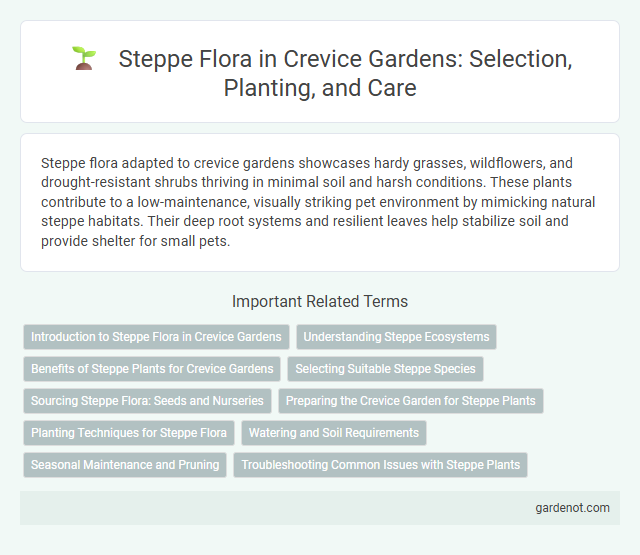Steppe flora adapted to crevice gardens showcases hardy grasses, wildflowers, and drought-resistant shrubs thriving in minimal soil and harsh conditions. These plants contribute to a low-maintenance, visually striking pet environment by mimicking natural steppe habitats. Their deep root systems and resilient leaves help stabilize soil and provide shelter for small pets.
Introduction to Steppe Flora in Crevice Gardens
Steppe flora in crevice gardens thrive by mimicking the dry, nutrient-poor conditions of natural steppe environments, enhancing drought resistance and adaptability. Key species include drought-tolerant grasses, cushions plants, and hardy perennials such as Stipa, Festuca, and Dianthus, which anchor soil and provide textural contrast. Incorporating native steppe flora improves biodiversity, supports pollinators, and creates visually striking, sustainable rock crevice landscapes.
Understanding Steppe Ecosystems
Steppe ecosystems thrive in vast, semi-arid grasslands characterized by drought-resistant flora adapted to extreme temperature variations and nutrient-poor soils. Crevice garden designs mimic these conditions by incorporating rock fissures that provide microhabitats for native steppe plants like feather grass (Stipa spp.) and wildflowers, supporting biodiversity and resilience. Exploring root structures and soil symbiosis within these gardens deepens understanding of steppe flora's survival strategies and ecological functions.
Benefits of Steppe Plants for Crevice Gardens
Steppe plants in crevice gardens thrive due to their drought tolerance and deep root systems, which stabilize soil and reduce erosion. Their adaptability to poor, rocky soils enhances garden resilience while providing seasonal interest with vibrant blooms and varied foliage textures. These plants also support local biodiversity by attracting pollinators and beneficial insects, promoting healthy garden ecosystems.
Selecting Suitable Steppe Species
Selecting suitable steppe species for crevice gardens requires prioritizing drought-tolerant and low-maintenance plants such as Festuca ovina, Stipa tenuissima, and Dianthus carthusianorum. These species thrive in well-drained, rocky substrates and mimic natural steppe conditions, ensuring ecological compatibility and visual harmony. Incorporating native steppe flora like Artemisia campestris enhances biodiversity and resilience within the microhabitat of the crevice garden.
Sourcing Steppe Flora: Seeds and Nurseries
Sourcing steppe flora for a crevice garden involves obtaining seeds from specialized nurseries that focus on native steppe plants adapted to dry, rocky environments. Reliable nurseries offer species such as Stipa, Artemisia, and Festuca, ensuring genetic authenticity and high germination rates. Procuring seeds during dormant seasons maximizes success in establishing a resilient steppe-themed crevice garden.
Preparing the Crevice Garden for Steppe Plants
Preparing the crevice garden for steppe plants involves selecting well-drained, nutrient-poor soil that mimics natural steppe conditions, ensuring optimal root aeration and moisture retention. Incorporate coarse sand and gravel to enhance drainage and prevent waterlogging, essential for the drought-tolerant flora typical of steppe environments. Position the garden in full sun exposure to replicate the high light levels of steppe habitats, promoting vigorous growth of resilient grasses, herbs, and drought-adapted shrubs.
Planting Techniques for Steppe Flora
Steppe flora in crevice gardens thrives by mimicking natural soil conditions and microclimates found in their native habitats. Planting techniques involve using well-drained, gritty substrates combined with deep crevices to protect roots from excess moisture and temperature extremes. Strategic placement ensures maximum sunlight exposure while allowing airflow to reduce fungal diseases, promoting robust growth of drought-resistant steppe species.
Watering and Soil Requirements
Steppe flora in crevice gardens thrive in well-drained, sandy or rocky soils that mimic their native arid environments, preventing root rot and promoting healthy growth. These plants require minimal watering, typically needing only deep, infrequent irrigation to simulate natural rainfall patterns and maintain drought tolerance. Proper soil composition combined with controlled watering ensures optimal nutrient availability and supports the resilience of steppe species in crevice garden settings.
Seasonal Maintenance and Pruning
Steppe flora in a crevice garden requires seasonal maintenance to ensure healthy growth and vibrant blooms, particularly through monitoring soil drainage and removing dead or diseased plant material. Pruning should focus on cutting back perennials in late winter or early spring, promoting airflow and preventing overcrowding in the narrow crevices. Regular inspection and careful trimming support the resilience of drought-tolerant species native to steppe environments.
Troubleshooting Common Issues with Steppe Plants
Steppe plants in crevice gardens often face challenges such as root rot from poor drainage and nutrient deficiencies due to shallow soil pockets. Ensuring well-aerated, gritty substrates and adjusting soil pH to mimic natural steppe conditions can effectively mitigate these issues. Regular monitoring for pests like aphids and timely pruning help maintain healthy growth and resilience in steppe flora.
Steppe flora Infographic

 gardenot.com
gardenot.com